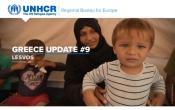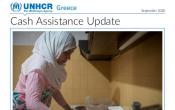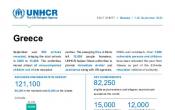Greece
Operation: Greece
Location
{"longitude":22,"latitude":39,"zoom_level":0,"iso_codes":"'GRC'"}
By clicking on the icons on the map, additional information is displayed.
The boundaries and names shown and the designations used on this map do not imply official endorsement or acceptance by the United Nations.
Key Figures
| 2019 year-end results | |
| 121,200 | individuals received direct cash support through UNHCR’s ESTIA progamme |
| 32,500 | individuals received accommodation through UNHCR’s shelter programme |
| 2020 planning figures | |
| 49,000 | households will receive cash grants |
| 25,000 | urban accommodation places established by UNHCR between 2016 and 2018 will be gradually handed over to the Government of Greece |
| 5,000 | people will benefit from legal assistance |
More Information
People of Concern
39%
Increase in
2019
2019
| 2019 | 190,900 |
| 2018 | 137,757 |
| 2017 | 83,418 |

[["Refugees",68219],["Refugee-like situation",12249],["Asylum-seekers",105698],["Stateless",4734]]
Loading ...
Greece
< Back
2019
{"categories":[2015,2016,2017,2018,2019,2020],"budget":[null,287.40068551,245.86626514000002,247.36028813000001,271.81191181,284.32519995999996],"expenditure":[null,183.87264811000003,217.74130145,236.72237511999998,253.17289963,null]}
{"categories":[2015,2016,2017,2018,2019,2020],"p1":[null,287.37282951,245.83840878,247.27133477,271.76191181,284.24095338],"p2":[null,0.027856,0.02785636,0.08895336,0.05,0.08424658],"p3":[null,null,null,null,null,null],"p4":[null,null,null,null,null,null]}
{"categories":[2015,2016,2017,2018,2019,2020],"p1":[null,183.84988105000002,217.73145452,236.67153789,253.14021803,null],"p2":[null,0.022767060000000002,0.00984693,0.050837230000000004,0.0326816,null],"p3":[null,null,null,null,null,null],"p4":[null,null,null,null,null,null]}
Loading ...
CHOOSE A YEAR
- 2015
- 2016
- 2017
- 2018
- 2019
- 2020
Operational context
Greece remained one of UNHCR’s largest operations in Europe in 2019. The operation focused on providing support to the Greek authorities in addressing asylum and reception needs for the increasing number of asylum-seekers, as well as the effective inclusion of people of concern in national social services and other structures to enhance prospects for self-reliance and socio-economic integration.In the second half of 2019, Greece experienced a significant rise in new arrivals, particularly by sea, exacerbating already difficult conditions on the islands in and around the island reception and identification centres (RICs), which resulted in the highest levels violence seen within the centres since 2016.
The operation continued to work toward a gradual transition of responsibility for the implementation of large-scale reception programmes (accommodation, services, cash-based interventions, and programmes for unaccompanied and separated children) to the Greek Government.
Population trends
At the end of 2019, Greece hosted approximately 186,200 refugees and asylum-seekers.2019 saw an increase in new arrivals, with over 74,600 people (80% by sea, 20% by land) compared to the 50,500 that arrived in 2018 (64% by sea, 36% by land). The sharp increase in sea arrivals occurred largely during the second half of 2019. Recognition rates increased from 49% in 2018 to 56% in 2019.
Achievements
- Quality support by UNHCR experts to the Greek Asylum Service was enhanced in 2019 to facilitate the expansion of the Service. This contributed to increased consistency in recognition rates.
- A guardianship programme for vulnerable UASC was established, with best interests procedures fully incorporated. Limited numbers of UASC were relocated under Dublin arrangements or placed in semi-independent living and foster care arrangements.
- Improvements in multisectoral response services for SGBV survivors and new initiatives to mitigate SGBV risks were realized, including the prioritization of survivors for accommodation and direct cash support, strengthened tools for communicating with communities, and the implementation of a community-based psychosocial support initiative.
- The collection of individualized data for solutions (skills, education and intentions) was expanded, with data collected for almost 40% of the population of concern. Together with support for municipal authorities, the data will be used to foster the local integration of refugees.
Unmet needs
- RICs on the islands remained very overcrowded and ill-equipped to provide dignified temporary shelter to the increasing number of new arrivals.
- Despite modest improvements, care and protection services for at-risk or unaccompanied and separated children, SGBV survivors, and highly vulnerable individuals remained inadequate. In large urban centres, homelessness and the growing risk of exploitation and abuse were of concern.
- The inability of families to exit temporary ESTIA accommodations highlighted the lack of integration prospects for people of concern. Lack of Greek language training, labor market orientation, livelihoods planning, skills certification, access to social benefits, finances for self-employment and vocational training remained significant challenges to meaningful local integration.
Working Environment
In 2019, it is expected that the vast majority (90%) of new arrivals entering Greece by sea through the island route will apply for asylum, on the assumption that the EU-Turkey Joint statement will continue to be implemented. Contrary to new arrivals in the islands, only 50 per cent of land arrivals are estimated to apply for asylum. The number of recognized refugees is expected to increase at a steady pace. Taking into consideration the limited capacity of relocation schemes outside Greece, the number of recognized refugees and asylum-seekers staying in Greece is expected to grow.UNHCR will capitalize on the progress made in the area of protection case management and protection responses in particular for unaccompanied and separated children and for SGBV prevention and response. The accommodation and cash-based interventions schemes could support a meaningful transition to self-reliance and pave the way for integration. By the end of 2019, over 80,000 refugees and asylum-seekers are expected to remain in the country. UNHCR will work closely with authorities, both at national and local level, to support national integration policies and to increase self-reliance opportunities.
UNHCR will mobilize protection-centered humanitarian coordination established at the point of delivery in view of further strengthen the Government's response capacity.
Key priorities
UNHCR’s multi-year transition strategy is built on the significant investments made in the accommodation scheme and related services, cash-based assistance and the transfers from the islands to the mainland. The transition, started in 2017, is expected to be close to conclusion by the end of 2020. In this regard, in 2019, UNHCR will need to continue the accommodation scheme in close cooperation with the Government and municipalities, the provision of cash assistance and the identification of and response to protection risks, particularly for children and women.UNHCR will maintain its protection monitoring and response role through advocacy and targeted interventions, especially in relation to child protection, SGBV, communications with communities, while overall protection considerations will continue to be mainstreamed through conscientious efforts in the country-wide cash and accommodation programmes. Specific focus will be placed on integration with a view to strengthen the national system as a whole to operate an inclusive approach towards refugees as well as to support refugees’ self-reliance.

























